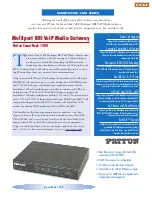
RIVERBED WHITEWATER QUICK START GUIDE
© 2012 Riverbed Technology. All rights reserved.
14
2. To add a CIFS share, complete the configuration as described in the following table.
Control
Description
Add CIFS Share
Displays the controls to add a new CIFS share.
Share Name
Specify the name of the share to be added.
Path
Specify the pathname to the share to be added. It starts with a forward slash (/).
Comment
Specify a comment about the share. You can only use alphanumeric, underscore (_), hyphen (-) characters and space in this field.
Read Only
Check this check box if you want the share to be a read-only share.
Allow Everyone Access
Check this check box to enable all clients connected to the Whitewater system to access the CIFS share.
Remove Selected
Deletes the selected CIFS share.
Add Share
Adds the CIFS share to the Whitewater CIFS server. The share you add appears in the list of shares on the page.
3. To add a CIFS user, complete the configuration as described in the following table.
Control
Description
Add CIFS User
Displays the controls to add a user to the Whitewater CIFS server.
User Name
Specify the user name of a user to access the CIFS shares.
Password
Specify the password to authenticate the user.
Password Confirm
Specify the password again to confirm authentication.
Remove Selected
Deletes the selected user name from the CIFS server.
Add
Adds the user name and password to the Whitewater CIFS server.
4. To add Whitewater to an Active Directory (AD) domain, complete the configuration as described in the following table.
Control
Description
Join Domain
Displays the controls to add Whitewater to your AD domain.
Domain Name
Specify the domain name of the AD that Whitewater must join. If your system has an AD domain, then you can add Whitewater to your AD
domain and create share permissions for AD users and groups.
User Name
Specify the user name of a user to access the AD domain. The user name must be a part of theAD and the user must have permissions to
add computers to the domain.
Password
Specify the password to authenticate the user.
DNS Domain
Optionally, specify the DNS name of the domain.
Organization Unit
Optionally, specify the organization unit within the domain to which Whitewater must join.
Hostname
Optionally, specify the hostname that Whitewater must use to join the domain. Whitewater then appears as the specified hostname in the
AD.
5. Under Global CIFS Settings, specify the values for SMB (Server Message Block) Signing and Guest Account. This setting
overrides the setting under Add CIFS User.
Select one of the following values for SMB Signing:
Disabled - The CIFS server does not offer SMB signing. This is the default value.
Auto - Enables SMB signing automatically. The CIFS server offers SMB signing, but does not enforce it. You can
choose to enable or disable it.
Mandatory - The CIFS server enforces SMB signing. You must use SMB signing if you select this option.
Select one of the following values for Guest Account:
Enabled - Activates the guest account. A user may authenticate as a guest user and access a CIFS share (which allows
guest users) using any user name and password. If you want to enable any user to access the share, you can use this
feature.
Disabled - De-activates the guest account.
Note: Windows provides the ability to sign CIFS messages to prevent man-in-the-middle attacks when sharing files. Each CIFS
message has a unique signature, which prevents the message from being tampered with.
Note: Enabling SMB signing degrades Whitewater performance.
















































